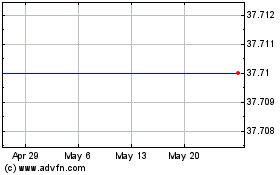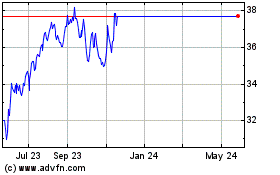The proliferation of ETFs has brought countless strategies to
the fingertips of average investors in recent years; through the
use of a single ticker, virtually anyone with an online brokerage
account can access a variety of asset classes from all around
the globe or tap into a professionally managed portfolio that was
once simply unreachable by self-directed investors [see also 101
ETF Lessons Every Financial Advisor Should Learn].
We recently had an opportunity to talk with Wesley Gray, Ph.D,
the leader behind Alpha Architect and the recently launched U.S.
Quantitative Value ETF (QVAL); he shares insights about his firm,
core investment beliefs, and the “secret sauce” that sets QVAL
apart from competitors.
ETF Database (ETFdb): What exactly is Alpha
Architect?
 Wesley Gray (WG): We are an
asset management firm that delivers high-conviction tax-efficient
strategies at affordable costs. I would describe us in a few simple
words: Affordable, Active, Alpha. We offer our strategies via
active Exchange-Traded Funds (ETFs) and Separately Managed Accounts
(SMAs).
Wesley Gray (WG): We are an
asset management firm that delivers high-conviction tax-efficient
strategies at affordable costs. I would describe us in a few simple
words: Affordable, Active, Alpha. We offer our strategies via
active Exchange-Traded Funds (ETFs) and Separately Managed Accounts
(SMAs).
Perhaps a more relevant question is the following: What do we
believe? There is certainly no shortage of asset managers who want
you to simply have faith in their proprietary methodology and
“special sauce.” Our experience with academia and
ultra-high-net-worth individuals has culminated in three core
beliefs that permeate everything we do:
- We believe in Systematic Decision-Making, not ad-hoc
decision-making. Disciplined and repeatable processes are more
reliable than discretionary judgment.
- We believe in Empirical-Based Investing, not story
based-investing. Rigorous, data-driven research drives success;
stories drive sales.
- We believe in Transparency, not black-boxes. We are
committed to having investors understand what we are doing.
So we are the antithesis of the stockpicker who relies on his
intuition and his compelling story, and who won’t tell you how he
makes his decisions, and therefore feels justified in charging you
high fees. We don’t buy this. By contrast, our firm is driven by
research and a desire to challenge this traditional way of doing
business in financial services. I have an MBA and a PhD in finance
from the University of Chicago and spent four years as a finance
professor. I have developed a deep respect for the value of
research, empiricism and discipline as it relates to applied
investing and behavioral finance.
My research team consists of my top PhD and Masters students. We
have worked together for nearly five years now on academic and
practitioner research questions and our faith in the research
process, on investing systematically, and on being up-front and
honest about what we are doing is continually reinforced the more
we work together. We find that the beliefs outlined above offer the
best framework for financial management and innovation [see also
Why Passive Investing Is More Active Than You Think].
ETFdb: What is your overarching philosophy with regard to
portfolio management? Please elaborate beyond the passive
versus active debate.
WG: We recognize the passive versus active debate can cause
people to fall into different camps. We’re not dogmatic about that.
Our philosophy does not involve strong views that one camp is right
and the other is wrong, since we think each has merits and can play
a role in an investment portfolio. Given this, we take a simple
approach to portfolio management and ask a simple question: What
are the FACTS? The FACTS are Fees, Access, Complexity, Taxes and
Search/Due Diligence. Once we have clarity on the FACTS, it then
becomes a simple comparison of costs versus benefits.

Our experience suggests that the majority of taxable investors
should focus on strategies with lower costs, higher accessibility
and liquidity, easily understood investment processes, higher
tax-efficiency, and limited due diligence requirements. So on its
face, this view would seem to make a strong case for passive
investing, but it also applies to questions related to active
management.
For instance, we often meet high net worth individuals (and even
RIAs) who are unaware of the tax deferral features within the ETF
vehicle or why an equal weight portfolio might make more sense than
some whiz-bang mean variance approach. Before we start debating
whether a strategy can yield an incremental 200 bps of so-called
“Alpha,” let’s make sure we address the big picture and minimize
fees, taxes, and due diligence headaches [see list
of Actively-Managed ETFs].
Generally speaking, the FACTS suggest that investors should make
use of more managed accounts and ’40 Act products, and rely less on
expensive, private funds. The academic evidence is overwhelmingly
in favor of simple, transparent, tax-efficient strategies versus
expense “black box” approaches.
ETFdb: What was the inspiration behind creating
the U.S. Quantitative Value ETF (QVAL)?
WG: We were inspired by two distinct sources: the limited
and expensive options provided by the market today for a
high-conviction high expected performance value strategy, and the
demand we observed from investors for a cheaper, more tax efficient
alternative to mutual funds and/or hedge funds.
Let’s start with the market itself. There are very few
high-conviction (<50 stocks) active ETFs in the market today,
and any non-ETF products out there are expensive. So if I want to
be a value investor and express my true conviction as such, I
either have to 1) save fees by doing the work myself and then get
killed on taxes OR 2) pay hedge fund / mutual fund fees to get that
effective high conviction exposure, and still get killed on taxes.
I cannot overstate this point on taxes: the taxes incurred during
any rebalancing make virtually every traditional vehicle
unattractive on an after-tax basis. That’s just the brutal reality
of options available to investors.
On the investor side, we had a deluge of interest from investors
with <$1M in investable assets. They were saying, “We want to do
this. How can we do this?” This demand reinforced our belief that
the market wanted an active ETF solution. You don’t have to be an
investing genius to see why this could make sense. So we reached
out to our multi-billion dollar family office partners and they
loved the idea. It was a perfect fit: a tax efficient, high
conviction strategy that suited both HNW investors and Main Street
investors [see also The Cheapest ETF for Every Investment
Objective].
With an active ETF, we can manage any account of almost any
size, and at an affordable price. You get a first class product,
and you don’t need to be a family office to negotiate a low fee.
Compared to other active options, such as mutual funds, quant hedge
funds, and the like, our management fee is a bargain. Second, we
capture the tax advantages of ETFs and apply them to an intelligent
active strategy. This is an issue that plagues “traditional” active
managers, since they can be forced to make buying and selling
decisions based on tax considerations, rather than based on
valuation and fundamentals.
ETFdb: What is QVAL’s objective and how does it actually
work? How does it differentiate itself from existing value-focused
funds?
WG: The QVAL objective is straightforward: Buy the
cheapest, highest quality value stocks. We deploy a five-step
process to accomplish our objective (see graphic below):
- Identify Investable Universe: Our universe generally
consists of mid- to large-capitalization U.S. exchange-traded
stocks.
- Forensic Accounting Screens: We conduct financial
statement analysis with statistical models to avoid firms at risk
for financial distress or financial statement manipulation.
- Valuation Screens: We screen for stocks with low
enterprise values relative to operating earnings.
- Quality Screens: We rank the cheapest stocks on their
long-term business fundamentals and current financial
strength.
- Invest with Conviction: We seek to invest in a
concentrated portfolio of the cheapest, highest quality value
stocks, which maximizes our expected returns over the long run.
This form of investing is by definition contrarian, and requires
disciplined commitment, as well as a thorough understanding of its
theoretical and intellectual underpinnings in order to stick with
it, since it may underperform in the short run.

As for the second part of your question, as to how we are
differentiated from our competitors, there are a few factors.
First, we offer a rigorous, statistics-based defense against
permanent capital impairment. Second, we offer a very smart way to
screen for price, and have a lot of evidence to back up why we
think so. Third, we use a lot of the quality signals from the
philosophy of value investing that you often see used in
fundamental research shops, but we do so systematically across the
entire equity universe to identify the very highest quality
companies.
In the end, we systematically form our portfolio, rather than
picking a stock story we like and then back into some of the
value-related characteristics the stock happens to have [see also
When the Fine Print Matters for ETF Investors].
For example, you won’t hear us say, as you might hear a
fundamental shop say, “Hey, this stock looks pretty cheap based on
its P/E, and it has nice returns on capital and boy do we have a
good feeling about management.” Instead we are going to say, “This
stock is liquid enough not to cause problems, it is not
showing statistical signs something very bad is likely to happen,
it is objectively cheap using the best valuation tools we can find,
and it is doing these 10, 12 or 15 financial things right that Ben
Graham and very bright academics have shown us we should pay
attention to, therefore it sure looks like a decent statistical bet
on its own but we want to include it as part of a basket of other
similar securities, and equal weight them to give you the best
chance to succeed over time.”
That is a very different investment proposition than relying on
the hot manager du jour, who relies on what their gut is saying, is
subject to behavioral biases, and who claims to be a value
investor. We just don’t believe there are many value investors out
there of this latter ilk who are worth paying what they are
charging for their services.
One of our clients was describing us to another investor and
said, “These guys are not quants, they are value investors.” And
that’s right. We really are value investors just like any of these
fundamental managers are, or claim to be, since we are looking at
exactly the same accounting-based measures and metrics, BUT — and
here’s the difference — we are doing so in a rigorous and
systematic way, using academic research, and quantitative tools,
and eliminating the chance we will be influenced by our faulty
human biases. Finally, we do so cheaply and in a tax-efficient
wrapper via the ETF. These are what differentiate us from the
competition.
The Bottom Line
Utilizing a value-focused investment approach is
as desirable as it is difficult. For those looking to tap into
an actively-managed portfolio that offers concentrated exposure to
high-quality, undervalued equities, QVAL most certainly warrants a
closer look; this product separates itself from the pack by
adhering to a strict process that takes emotion and bias out of the
equation all the while relying on hard data to steer allocation
decisions rather than compelling stories.
Follow me on Twitter @SBojinov
[For more ETF analysis, make sure to sign up for our free ETF
newsletter]
Disclosure: No positions at time of writing.
Click here to read the original article on ETFdb.com.
Alpha Architect US Quant... (AMEX:QVAL)
Historical Stock Chart
From Aug 2024 to Sep 2024

Alpha Architect US Quant... (AMEX:QVAL)
Historical Stock Chart
From Sep 2023 to Sep 2024
